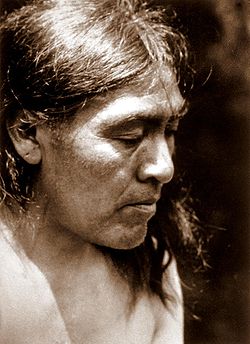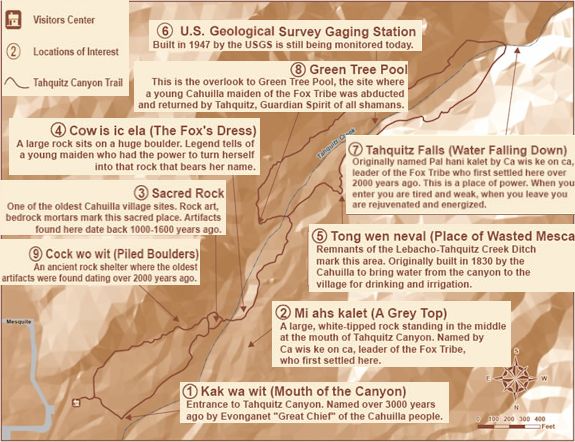The twenty-one Spanish missions in California established by Catholic priests of the Franciscan order between 1769 and 1834, were supposed to expand Christianity among the Native Americans living in the area. The local natives were forcibly relocated from their traditional dwellings, villages, and homelands to live and work at the missions as virtual slaves.
California Tribes
California Tribes
Also see: California Indians
Location: Modern California and Baja Peninsula.Terrain: Coastal mountain range,Sierra Mountains,Pacific Ocean,Desert,Large rivers. Has a high population density and a great variety of plants and animals.
NORTHWESTERN CALIFORNIA TRIBES
This area included the Tolowa, Shasta, Karok, Yurok, Hupa, Whilikut, Chilula, Chimarike and Wiyot tribes. The distinctive northern rainforest environment encouraged these tribes to establish their villages along the many rivers, lagoons and coastal bays. While this territory was crisscrossed with thousands of trails, the most efficient form of transportation was the dugout canoe. These tribes used the great coast Redwood trees for the manufacture of their boats and houses. Redwoods were cleverly felled by burning at the base and then split with elkhorn wedges. Redwood and sometimes cedar planks were used to construct rectangular gabled homes. Twined baskets in a variety of designs were manufactured. Many of these survived into the twentieth century and this traditional skill has enjoyed a great renaissance in the past twenty years.
The elaborate ritual life of these tribes featured a World Renewal Ceremony held each Fall. Sponsored by the wealthiest men in the communities, the ceremony’s purpose was to prevent future natural catastrophes such as earthquakes, floods or failure of acorn crops or a poor salmon run. This and other traditional rituals continue to be practiced, despite the grinding poverty of many of these groups.
Northwest California tribes were governed by the most wealthy and powerful lineage leaders. The great emphasis on wealth found in these cultures is reflected in the emphasis on private ownership of food resources such as oak groves and fishing areas.
NORTHEASTERN CALIFORNIA TRIBES
This region included the Modoc, Achumawi, and Atsugewi tribes. The western portion of this territory was rich in acorn and Salmon. Further to the East, the climate changed from mountainous to a high desert type of topography. Here food resources were grass seeds, tubers, berries, along with rabbit and deer.
North eastern California Indians found tule to be a useful source of both food (the rootbulb is consumed) and a convenient material when laced together to form floor mats and structure covering. Volcanic mountains in the Western portion of their territory supplied the valuable trade commodity obsidian. The Social-political organization of these peoples was independent but connected to their neighbors by marriage ties. Following contact, the Achumawi and Atsuguewi suffered a tremendous population decline due to vigilante violence and respiratory diseases. The Modocs spectacular 1872 resistance to removal to the Oregon territory was the last heroic military defense of native sovereignty in 19th century California Indian History.
Some surviving Northeast tribesmen received public land allotments around the turn of the century. The XL Rancheria was established for some of these Indians in 1938. Tragically, the surviving Modocs were exiled to either Oregon or Oklahoma.
Northern California Tribes:
Alturas RancheriaBear River Band of Rohnerville RancheriaBig Lagoon RancheriaBlue Lake RancheriaCedarville RancheriaElk Valley RancheriaFort Bidwell ReservationNorthern California AgencyPit River Tribal CouncilQuartz Valley ReservationResighini RancheriaSusanville Indian RancheriaTrinidad Rancheria
CENTRAL CALIFORNIA
Central California was the territory of the Bear River, Mattale, Lassick, Nogatl, Wintun, Yana, Yahi, Maidu, Wintun, Sinkyone, Wailaki, Kato, Yuki, Pomo, Lake Miwok, Wappo, Coast Miwok, Interior Miwok, Wappo, Coast Miwok, Interior Miwok, Monache, Yokuts, Costanoan, Esselen, Salinan and Tubatulabal tribes.
All of these tribes relied on the acorn nuts and salmon that could be readily obtained in the waterways north of Monterey Bay. Deer, elk, antelope, and rabbit were also harvested in vast quantities.
Basketry reached the height of greatest variety in the Central California region. The Pomo basket makers created the most elaborate baskets. Both coiled and twined type baskets were produced throughout the region. Fortunately basket making survived the years of suppression of native arts and culture to once again become one of the most important culturally defining element for Indians in this region.
The semi-subterranean roundhouse was common in this area. Kuksu dances were held in the past and continue to this day. These rituals assure the renewal of the world’s natural foods, both plant and animal. Despite differences between tribes, these rituals share similar purposes.
Villages were fiercely independent and governed internally, The abundant food supplyallowed for the establishment of villages of up to 1000 individuals. Each family produced all that was necessary for survival.
Central California Tribes:
Bear River Band of the Rohnerville Rancheria
Benton Paiute Reservation
Berry Creek Rancheria
Big Pine Paiute Tribe of the Owens Valley
Big Sandy Rancheria
Big Valley Rancheria
Bishop Paiute Tribe
Bridgeport Indian Colony
Buena Vista Rancheria
Cahto Tribal Executive Committee
California Valley Miwok Tribe
Chicken Ranch Rancheria
Cloverdale Rancheria
Cold Springs Rancheria
Colusa Rancheria
Cortina Rancheria
Coyote Valley Reservation
Dry Creek Rancheria
Elem Indian Colony
Enterprise Rancheria
Federated Indians of Graton Rancheria
Fort Independence Reservation
Greenville Rancheria
Grindstone Rancheria
Guidiville Rancheria
Habematolel Pomo of Upper Lake
Hopland Reservation
Ione Band of Miwok Indians
Jackson Rancheria
Lone Pine Paiute Shoshone Reservation
Lower Lake Rancheria
Lytton Rancheria
Manchester-Point Arena Band of Pomo Indians
Mechoopda Indian Tribe of the Chico Rancheria
Middletown Rancheria
Mooretown Rancheria
North Fork Rancheria
Paskenta Band of Nomlaki Indians
Picayune Rancheria of Chukchansi Indians
Pinoleville Reservation
Potter Valley Tribe
Redwood Valley Reservation
Robinson Rancheria
Round Valley Reservation
Rumsey Yocha Dehe Winton Nation
Santa Rosa Rancheria
Scotts Valley Rancheria
Sherwood Valley Rancheria
Shingle Springs Rancheria
Stewarts Point Rancheria
Table Mountain Rancheria
Tejon Indian Tribe
Timbi-Sha Shoshone Tribe
Tule River Reservation
Tuolumne Rancheria
United Auburn Indian Community
SOUTHERN CALIFORNIA TRIBES
Southern California presents a varied and somewhat unique region of the state. Beginning in the north, tribes found in this area are the Chumash, Alliklik, Kitanemuk, Serrano, Gabrielino Luiseno Cahuilla, and the Kumeyaay. The landmass and climate varied considerably from the windswept offshore channel Islands that were principally inhabited by Chumash speaking peoples. Communication with their mainland neighbors was by large and graceful planked canoes powered by double paddle ores. These vessels were called “Tomols” and manufactured by a secretive guild of craftsmen. They could carry hundreds of pounds of trade goods and up to a dozen passengers. Like their northern neighbors, the Tactic speaking peoples of San Nicholas and Santa Catalina Islands built planked canoes and actively traded rich marine resources with mainland villages and tribes. Shoreline communities enjoyed the rich animal and faunal life of the ocean, bays and wetlands environments. Interior tribes like the Serrano, Luiseno, Cahuilla, and Kumeyaay shared an environment rich in Sonoran life zone featuring vast quantities of rabbit, deer and an abundance of acorn, seeds and native grasses. At the higher elevations Desert Bighorn sheep were hunted.
Villages varied in size from poor desert communities with villages of as little as 100 people to the teaming Chumash villages with over a thousand inhabitants. Conical homes of arroweed, tule or croton were common, while whale bone structures could be found on the coast and nearby Channel Islands. Interior groups manufactured clay storage vessels sometimes decorated with paint. Baskets were everywhere manufactured with unique designs. Catalina Island possessed a soapstone or steatite quarry. This unique stone was soft and could easily be carved with cutting tools and shaped into vessels, pipes and cooking slabs.
Each tribe and community had a chieftain, sometimes females, whose duty it was to organize community events and settle conflicts among their followers. This leader was usually assisted by a crier or assistant.Shaman or Indian doctors were known everywhere and greatly respected. The ritual use of the hallucinogen jimsonweed (Datura meteloides) was primarily in male puberty rituals. Like other California Indian communities, society was divided into three classes, the elite, a middle class and finally a less successful lower class. These robust peoples were among the first to encounter the strangers who would change their world forever.
Southern California Tribes:
Augustine Band of Cahuilla Mission IndiansBarona Band of Mission IndiansCahuilla Band of Mission IndiansCampo Band of Mission IndiansEwiiaapaayp Band of Kumeyaay IndiansInaja-Cosmit ReservationJamul Indian VillageLa Jolla Band of Luiseno IndiansLa Posta Band of Mission IndiansLos Coyotes Band of Cahuilla and Cupeno IndiansMesa Grande Band of Mission IndiansMorongo Band of Mission IndiansPala Band of Mission IndiansPauma/Yuima Band of Mission IndiansPechanga Band of Mission IndiansRamona Band of Mission IndiansRincon Band of Mission IndiansSan Manuel Band of Mission IndiansSan Pasqual Band of Diegueno IndiansSanta Rosa Band of Mission IndiansSanta Ynez Band of Mission IndiansSanta Ysabel Band of Mission IndiansSoboba Band of Luiseno IndiansSouthern California AgencySycuan Band of the Kumeyaay NationTorres-Martinez Desert Cahuilla IndiansTwenty-Nine Palms Band of Mission Indians
All California Tribes
Achomawi (Pit River Indians)
Antoniaño (See Salinan)
(Pit River Indians)
Bear River
Cahuilla (Also see Mission Indians)
Campo Band of Diegueno Mission Indians
Campo
Chemehuevi
Chukchansi
Chumash (Dialects: Roseño, Purisimeño, Barbareño, Inezeño, Ventureño, Obispeño, Santa Paula, Cruzeño, Emigdiano Allilik)
Chilula (See Hoopa)
Chimariko
Coast Miwok (See Federated Indians of Graton Rancheria
Costanoan (Dialects: Ramaytush, San Jose, Juichen, Chocheño, Tamyen, Awaswas, Chalon, Mutsun, Rumsen)- See Ohlone
Cupeño
Diegueño – see Kumeyaay
Esselen
Fernandeño: see Tataviam
Gabrieliño: see Tongva
Giamina
Huchnom
Hupa
Ipai – see Kumeyaay
Jamul
Juaneño
Kamia
Karok
Kato
Kiliwa
Kitanemuk
Klamath
Konomihu
Konkow – see Maidu
Kumeyaay (Diegueño)
Lake Miwok
Lassik
Luiseño
Maidu
Mattole
Mesa Grande
Migueleño
Mission Indians
Miwok (Me-wuk)
Modoc
Mohave
Monache
Nakipa
Niprise
Nisenan
Nomlaki
Nongatl
Ohlone
Okwanuchu
Paipai (Akwa’ala)
Paiute (Northern, Southern)
Patwin
Pit River – see Achomawi
Pomo
Quechan
Rumsen
Salinan
San Clemente
San Nicolas
Santa Catalina
Serrano
Shasta tribe
Sierra Miwok
Sinkyone
Suisunes
Tache
Tachi tribe
Tataviam (Fernandeño)
Tipai
Tolowa
Tongva (Gabrieliño)
Tsnungwe
Tubatulabal
Valley Miwok
Wailaki
Wappo
Washoe
Whilkut
Wintu
Wintun
Wiyot (Also see California Rancherias)
Yahi
Yana
Yelamu
Yocha Dehe
Yokuts
Yuki (Ukomno’m)
Coast Yuki
Yurok
Arctic
California
Northeast
Great Basin
Great Plains
NW Coast
Plateau
Southeast
Southwest
Sub Arctic
Rep. Jared Huffman introduced a bill this week to take land near Windsor into federal trust for housing and other purposes — but not a casino — as part of the Lytton Rancheria reservation.
California Indian Wars
22 ViewsBecause of the small U.S. Army garrison west of the Rockies, and the economic and political effects of the California Gold Rush, most of the early conflicts with the mostly unwarlike California Indians involved local parties of miners or settlers.
Four tribal groupings make up the indigenous Indians of San Diego County: the Kumeyaay/Diegueño, the Luiseño, the Cupeño, and the Cahuilla.
The Diegueño are the largest group, and are classified in the Yuman language family, Hokan stock. They are divided into the Ipai (the northern dialectical form) and the Tipai (the southern dialectical form). The Southern Diegueño are known in their language as the Kumeyaay.
Ishi: The last Yahi Indian
22 ViewsAt the quiet center stood a man. He never said his real name — to say it aloud to strangers would be unthinkable for a California Native American from the Yahi tribe — so he became known as Ishi, his people’s word for man. He spent almost 40 years living in isolation in the Mount Lassen foothills, one of the last dozen Yahi who hid themselves to avoid the white men who nearly wiped out their tribe.
After a 30-year closure, the lovely canyon named after a banished Cahuilla shaman called Tahquitz has reopened on a limited basis to hikers in Palm Springs. Tribal rangers lead daily hikes through the storied canyon, which is two miles as the phainopepla flies southwest of downtown.

